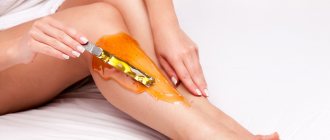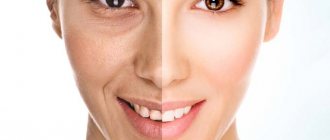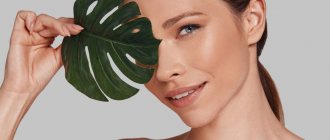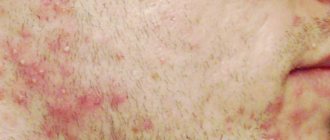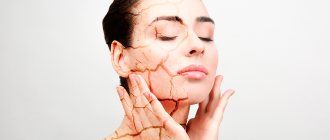Five tests to find out your skin tone
Cosmetics manufacturers and makeup artists distinguish between seven basic skin tones.
Almost like the seven colors of the rainbow! These are: - Very Fair - Pale (Fair) - Medium - Olive - Dusky - Tan - Dark
It is equally important to know not only your shade, but also your undertone, or subtone. Before we move directly to the tests, we should decide what skin undertone is.
What is skin undertone?
No matter what color your skin is, it also has an undertone: warm or cool. There are three types of undertones:
- warm, - cold, - neutral (or medium).
Warm skin tone
- This is skin close to a yellow tint. At the same time, it doesn’t matter whether the skin is light or dark. For example, the skin of Kim Kardashian, Jennifer Lopez, and Ashley Olsen can be classified as warm tones.
Cold
- This is bluish or pink skin. Celebrities such as Angelina Jolie, Anne Hathaway, singer Adele, and Liv Tyler have cool skin tones.
Neutral shade
– not so common, this is skin that is difficult to classify as warm or cool undertone, that is, yellow, bluish and pink to the same extent.
Most Asian women have warm skin tones, but Western women have cool skin tones. Indians have warm and neutral undertones, South Asians (Japanese, Chinese, Koreans) have yellow skin with warm undertones, Africans can have warm or cool skin. Americans, Germans, Russians, and Norwegians generally have a cool skin tone, but Greeks, Italians and Spaniards have warm skin tones.
The theory is over, let's move on to practice, actually, to tests.
TEST 1. Check the veins
Take a close look at your wrist veins. Determine their color: - Blue veins - you have a cool skin tone - Green veins - warm skin tone - Both blue and green veins - you have a rare, neutral skin tone.
TEST 2. Sheet of paper
It is often difficult to determine your skin tone, because bright hair is next to your face, jewelry reflects reflections on your skin, and your skin is set off by colored clothes. Therefore, a simple method has been invented - you need to compare your skin with pure white color.
As a standard of whiteness, we take an A4 sheet of good paper, pure white in color and without texture (flat and smooth). We look at ourselves in the mirror, and hold a piece of paper next to our face. Naturally, you must be without makeup during the test. Against the background of white paper, it is quite easy to immediately understand whether the skin is warm or cold. Check it out, it really works!
TEST 3. Jewelry test
For this test you need a lot of jewelry - gold (or gold-like) and silver. Put on as much jewelry as possible at the same time. And see which ones look better on you. Which metal does your face best harmonize with?
- If these are gold jewelry, then you have warm skin. That is why the largest consumers of gold jewelry are Indian and Chinese women, but silver jewelry and items made of white gold and platinum are more popular among European women.
- If your skin looks better with white metal jewelry, then you have a cool skin tone.
— If both gold and silver look equally good on you, you have neutral skin. You are lucky with the choice of jewelry - you can safely buy any.
TEST 4. With fabric
You need bleached fabric and old white fabric (it is not pure white, a little yellowish-grayish). Throw both fabrics over your shoulders: on each shoulder - different fabrics. Look in the mirror. What fabric makes your skin bright? Which color makes your skin stand out the most? - If it is a snow-white fabric, then you have a cool skin tone - If you are better set off by a not very white fabric, then you have a warm skin tone. Although white color looks good on any skin, it makes warm skin look somewhat faded and colorless.
This test is difficult to do on your own; you need either a good mirror or an attentive assistant. Because you need to check the color of the skin behind the ears. If the skin behind the ears is warm, close to a yellow tint, then the whole face can be classified as a warm type. If the skin behind the ears is light and pink or bluish, then your type is cold.
Now it will be easier for you to determine your color type, which means choosing lipstick, eye shadow, and hair color.
Neutral test
What do you think: gold or silver jewelry suits you better (the question is not what you like best, but what actually gives your skin a glow, with which jewelry it looks fresher and healthier).
Typically, girls with cool skin tones go for jewelry made of silver and platinum, while warm skin harmonizes better with gold. Think about which neutral colors complement your beauty. Does your skin, eyes, and overall face look better with clean whites and blacks, or with ivory, off-whites, and browns? If the first statement is true, then you most likely have a cool undertone, and in the second case, you have a warm undertone.
How to determine skin undertone
As you know, any color can be described by three characteristics
-
lightness, brightness and hue
.
Closely related to the concept of color tone is “color temperature”
. What is it? I think you have often heard phrases like: “Cold red suits her, but warm red does not suit her.” Let's figure out what the color temperature characteristic means.
Psychologically, people divide the color wheel into warm ones
and
cool colors
. Colors with a predominance of yellow and red are warm because they are associated with the sun and fire, while colors with a predominance of blue are cool because blue reminds us of water and ice.
However, not every red can be called a warm color and not every blue can be called a cool color. This happens because any color can be decomposed into two components - tone ( overtone)
and
undertone
. _ The tone is the main color - i.e. green, yellow, purple, etc., and the undertone is the color "additive". For example, green with yellow added is a warm shade of green, while green with blue added is a cool shade of green. All chromatic colors except orange have warm and cool variants. Orange has only warm shades.
Compare cool and warm shades of the same color
Typically, each individual person wears either colors with a warm undertone, or colors with a cool undertone, or neutral colors that are close to the warm-cold border. The choice of clothing colors, hair color and makeup depends on this color characteristic.
To determine which colors - warm, cool or neutral - are right for you
, there are 4 ways:
I will distribute them in order of increasing importance.
1) Look at your veins 2) Compare gold and silver 3) Try lipsticks in warm and cool shades on your skin 4) Test with fabric in warm or cool undertones
1. Vein test
Look at your veins on your wrist and in the crook of your elbow. If their color is bluish-green, then most likely you have a warm type. If their color is bluish-lilac, then most likely you have a cold type. If you have both greenish and bluish veins, then you are a neutral type, with a slight predominance of warm or cold shades.
2. Test with gold and silver
There are two options for this test. Both require good natural lighting and two pieces of jewelry - gold and silver. Instead, any silver or golden metal will also work. Option 1 - in natural light (not in the bright sun - it also changes colors), without makeup, sit in front of a mirror so that the light falls on your face. Bring silver to your face first, then gold, and see what harmonizes better. Forget for a moment about personal preferences “I like silver, but I don’t like gold”; it’s not a matter of preference, but of type. Usually, “not your” metal does not fit into the overall picture of appearance. Option 2 - in natural light against a neutral background, put gold and silver jewelry on your hand together and see what looks more harmonious.
Skin tone color palette
– very light (this includes whites, snow whites);
– light (an example is most of European Russia in winter and spring);
– average (the same most of European Russia, but in the summer, rested and tanned);
– olive;
– dark-skinned (this could include mulattos and oriental girls);
– dark (African women, there are practically no cosmetics for this shade on our website).
https://www.youtube.com/watch?v=upload
Based on the given gradation from pale skin tone to the darkest, we think you can easily classify yourself as one type or another. It is also important to remember that even the cosmetics manufacturers themselves very often classify one or another cosmetic product to two adjacent skin tones: for example, cosmetics can be intended for medium and dark skin, or for light and very light skin. This means that the choice here is not so clear-cut, and there are borderline shades. In general, it's hard to make a mistake.
It has a bluish tint. It seems as if a person with this type of skin is never exposed to the sun at all. It includes shades such as porcelain and ivory - very light, almost transparent.
To determine skin tone and determine whether it is warm or cold, girls can take a test that will be reliable even if you do it yourself at home. An important condition: this must be done in natural light. Electric lamps distort perception.
Look at the inside of your wrist - where the veins are visible. If they appear blue or purple, then your skin is cool toned. If they appear to be green, it means your skin tone is warm. Is it difficult to understand what color the veins are? In this case, the tone is most likely neutral - neither warm nor cold; This is typical for those with an olive skin tone.
How to determine your color type in 2 minutes
Clear instructions for those who find it difficult to choose clothes and cosmetics.
Everyone knows that Irish green dresses suit redheads, and scarlet lipstick suits those with jet-black curls and porcelain skin. The same green outfit can turn a fair-haired girl with gray eyes into a standard gray mouse. A delicate blue-eyed blonde will also most likely get lost against the backdrop of bright red lip gloss.
Why is that? There is an opinion that it is a matter of color type. Note: this concept is very conditional and in many ways imperfect. Modern professional stylists do not use it because they dig deeper.
Still, it’s worth having an idea of your color type. At a minimum, this will help you understand why your friend’s scarf doesn’t suit you, make it easier to select a wardrobe and save you from frankly disastrous purchases.
How to determine the color type of appearance
It only takes three steps.
Find out if you are a cold or warm type
There are three ways to do this. Choose the one that is more convenient, or use all at once - for reliability. In any case, it will take a matter of seconds.
Method 1. Through the veins
Go to the window on a sunny day and look at the wreaths on your wrist. If they are distinctly blue, your type is cold. If you detect at least a hint of a greenish undertone in the color, your type is warm.
Method 2. Using a white napkin
Stand in front of a mirror in a well-lit room and place a white napkin on your face. Take a closer look at what shade your skin takes on against its background. Slightly pinkish - your type is cold. Yellowish - warm.
Method 3. For gold and silver
You will need two pieces of paper, fabric or foil - one gold, one silver. Apply them one by one to the skin around the wrist. Against the background of your color, the skin will have a uniform, healthy shade. Against the background of the second one it will seem gray, faded, spotted.
If silver suits you, your type is cold. Gold is warm.
By the way, gold bracelets, necklaces, and earrings look good on warm-type people. Cold-type people prefer silver.
Determine your contrast
It's quite simple. Look at your face in natural light.
If the color of your eyes, hair or skin stands out strongly from the rest, you are a contrasting type. A prime example of this type is the classic Disney Snow White with black hair, dark eyes and porcelain skin.
A little less bright, but still indicative - Cinderella with her white skin, piercing blue eyes and bright blonde hair.
If the colors of your eyes, hair and skin resonate with each other, you are a muted type. Disney examples are Rapunzel and Tinker Bell.
Compare the results
The seasonal color type is determined based on temperature and contrast.
- Cold and contrasting - winter.
- Cold and muted - summer.
- Warm and contrasting - autumn.
- Warm and muted - spring.
Determining skin tone
As we established earlier, skin tone does not refer to shade or undertone. This characteristic determines which color group the immediate color of your skin belongs to. Essentially, the tone is a consequence of the content of a certain amount of melanin or pigment in the epidermis and does not change from exposure to the sun or skin diseases (rosacea, acne). That is, even when a person’s skin becomes pale in winter or dark in summer, the skin tone remains the same.
Skin tone can be cool (often with bluish, pink or ruddy undertones), warm (yellow, yellowish, peach and gold undertones) or neutral (has no obvious undertone).
Experiment 1. Look at the color of the veins in the wrist area. If the veins look blue or purple, you have a cool skin tone; if they are green, you have a warm skin tone; if neither, then you are most likely neutral. By the way, a neutral tone is often accompanied by an olive undertone.
Experience 2. Remember how the skin usually reacts to the sun. If your tan sticks easily and you rarely burn, you have more melanin and likely have a warm or neutral skin tone. Conversely, if you burn quickly and the tan doesn't stick, you have less melanin and therefore a cooler skin tone.
Experiment 3. Hold a white sheet of paper to your face. Looking in the mirror, try to determine what the skin looks like next to a white sheet. If your skin looks sallow or sallow, you have a warm tone; if pink, blue or bluish-red, then a cold tone; if gray, then a neutral tone. If it is impossible to determine any color in this experiment, then you also most likely have a neutral skin tone.
Try 4: Use gold and silver foil or decorations to determine the tone. Hold a piece of gold foil to your face so that it reflects the light on your skin. See whether this reflection decorates the face, or, on the contrary, makes it grayish and lifeless. Then do the same with a sheet of silver foil.
If gold foil highlights look best, you have a warm skin tone. If it's silver, you have a cool skin tone. If you don't notice a difference (both have a shimmer to them), then you're probably neutral. In the absence of foil, this experiment can be carried out with jewelry: which metal (gold or silver) looks best on the wrist?
Experiment 5. Ask someone to look at the skin behind the shell of your ear, just above the lobe. If the skin there is yellowish, then the skin tone is warm, if pinkish, then the skin tone is cold.
Now that the tone has been determined, we must warn you: using mineral makeup, which we classify as cool or warm tone, does not always guarantee the best result. For example, in rare cases, foundations that we classify as "cool" tones can make the skin appear overly pink when applied, while those classified as "warm" tones can make the skin appear overly yellow.
If you have a cool tone, your chosen foundation should look a little pinkish in the jar. If the tone is warm, it will be better if the powder has a slight yellow or golden tint.
What if your color type is winter
People with this color type are distinguished by dark hair - from chestnut to blue-black, bright dark brown, green or blue eyes, and white skin.
Winter people are not suitable for desaturated colors with warm undertones - beige, orange, warm pink and blue.
This includes rich shades with a cold undertone - silver, emerald, deep gray, bright blue and cyan, red, purple, wine, black.
It is enough that one of the suitable colors dominates the image. The rest can be anything. The main thing is that they are combined.
Determining skin undertone
When classifying according to this criterion, there should also be no problems if you do not suffer from color blindness. Skin undertone is the color that is closest to it from the color palette at the moment. Skin undertone, like shade, can change over time and depending on the season.
On our website we have divided cosmetics into five main undertones: for beige, yellow, olive, peach and pink. These are the colors that are most often found among our customers and are most in demand.
What if your color type is spring
Spring people are distinguished by thin, transparent, light skin. Their hair is warm in tone - from blond to light brown (wheat, honey, golden). The eyes are blue, brown, gray, green, but always light. There are often soft pink lips and a slight blush.
Dark contrasting colors with a cold undertone are not suitable for spring - black, bright blue (electric blue), deep violet, scarlet, purple, and so on.
Light pastel colors - creamy, peach, warm beige, milk chocolate, salmon, apricot, light blue, light gray, light orange, as well as bright delicate shades of blue and pink.
What is skin tone and undertone
Skin undertone refers to its shades. According to this criterion, many makeup artists can determine which colors may be suitable - cold or warm. The warm range includes shades with yellow, peach, and golden colors, and the cold range includes bluish, pink, and purple.
Neutral are considered tones in which the main criterion of warmth and cold is difficult to discern. For this reason, it is difficult to determine whether the appearance is warm or cold. It may contain tones with yellow, bluish, pink colors.
How to determine your appearance color type, what color schemes are available, examples, online test
Each person has his own color type of appearance: winter, spring, summer, autumn. A certain color scheme in makeup, hair color, clothing can transform you beyond recognition. With the right colors, your skin will acquire a healthy glow, your eyes will become more expressive, and your lips will glow with sensuality. In addition, a well-chosen wardrobe of colors will help to divert attention from flaws and highlight the strengths of your figure.
Let's talk in more detail about how to find out your color type of appearance by hair, eye color, skin tone. We will see examples of women in the summer, spring, winter, and autumn categories. Let's find out which palette is right for you: warm or cold. And if you are not sure that you have understood color correctly, at the end of the article you will find a test to determine your individual appearance color type. You can get an accurate diagnosis for free.
What is an appearance color type?
Probably everyone has noticed that after putting on a certain thing, the eyes flash with fire, and the face becomes refreshed. Or, on the contrary, an unsuccessful wardrobe item gives the skin a gray tint and, in general, creates a tired look. This is the correct choice of suitable color scheme.
The color type of appearance is a person’s natural palette, embedded in the natural color of hair, eyebrows, eyes, skin tone, and its tendency to tan.
Stylists have developed a classification that has a parallel with the seasons. So, each person belongs to a certain species:
- Winter - pale, porcelain skin or dark with a cold undertone, dark hair, bright eyes.
- Spring - warm shades on the face, wheat or walnut curls, light eyes.
- Summer - cool blondes, ashy strands, soft pink skin, greenish eyes.
- Autumn is a red-haired beast with peach or honey skin tone and olive or blue eyes.
In addition to color, each color type of appearance is determined by whether a person has a cold or warm natural palette. So autumn and spring are characterized by warm shades, and summer and winter - cold. A detailed description helps you choose colors for your individual look: clothes, hair color, makeup palette. The right shades will always be in harmony not only with your appearance, but also with each other.
The color type of appearance remains unchanged throughout a person’s life. No matter what changes a person undergoes: changing the shade of his hair, eye color with the help of lenses, tanning or lightening his face - the color type remains unchanged. It is also worth noting that there are no mixed types of appearance.
Description of 12 appearance color types, examples, coloring
Each person clearly belongs to a specific color group. The palette changes, like the climate of the seasons: soft, natural, bright. Let's take a closer look at the expanded classification.
Appearance color type: winter
This type includes spectacular girls with bright natural characteristics, who are characterized by contrasts.
Hair: brown, black with an ash or blue tint, sometimes cold, bright blond. Golden tones excluded. Eyebrows and eyelashes to match with strands.
Skin color: pale with a porcelain or bluish undertone and a slight blush, prone to sunburn. There is another type: dark, olive skin, which acquires an even, dark shade when tanning.
Eyes: deep, bright, with a clear outline. The palette is varied: green, blue, gray-blue, brown, pitch black.
The lips of the representatives are most often pale in color or with an olive undertone.
There are also subtypes of the winter color type:
- Natural. This includes girls with pale, cool-toned skin and brown hair.
- Dark. Representatives with dark skin, almost black hair with a blue tint.
- Bright. Contrasts predominate in appearance: light eyes and dark hair, cold blond and blue eyes, or brown eyes and pale skin.
Appearance color type: natural winter Appearance color type: dark winter Appearance color type: bright winter The
natural beauty of the winter color type is adequately emphasized by cold, bright shades: black, blue, gray, white. Blue and pink colors will suit your face. Tones are also favorable: lilac, wine, lemon, emerald, chocolate. It is better to give preference to plain things with strict lines without floral prints. Add an accent with bright accessories and makeup.
It is worth abandoning neutral, muted shades: pastel, peach, and golden-red palette. Such colors in clothes will blur the brightness of your appearance, making the image nondescript.
Appearance color type: spring
This is the warmest and lightest look. Representatives of the category are gentle and airy girls, who are characterized by a muted natural palette.
Hair: Shades range from light wheat to hazel, but in any case with a golden sheen. Over time, the tone may darken, but will still give off a reddish look. Strands are often curly. Eyebrows and eyelashes to match or slightly darker than hair.
Skin color: ivory, light milky, peach or golden undertone. Thin, delicate skin with a pronounced blush on the cheeks and golden freckles. On light skin, the tan develops a reddish tint, while golden tones darken to bronze.
Eyes: light brown, green, pale blue, gray, but in any case of a light palette.
Lips: Pale peach to scarlet.
The “spring” color type has subtypes:
- Soft. This look is considered a classic spring with blurred, smoothly transitioning shades.
- Gold. It is considered transitional from “spring” to “autumn”. Characterized by golden-reddish hair.
- Bright. This is the transition from winter to spring. There is a contrast between skin and hair. The curls can be nutty, and the skin has a milky undertone.
Appearance color type: soft spring Appearance color type: golden spring Appearance color type: bright spring
It is recommended for a spring girl to choose fresh, natural colors for her outfits: white, beige, salmon, pink, golden, caramel. To add an accent you can use: lilac, soft red and blue, turquoise shades. When choosing things, it is better to give preference to plain fabrics with discreet prints. Large accents will overshadow the appearance of a gentle spring girl.
Representatives of the category should avoid cold and dark shades, as well as contrasting, clear colors. They will suppress natural femininity.
Appearance color type: summer
It is considered the most common color type. The palette is cold and rich, but not contrasting.
Hair: gray-ash, light steel or dark brown, possibly chestnut with a cold tint. Deprived of rich colors. Eyebrows and eyelashes to match the strands. Representatives of this particular category often do not accept their natural mouse color and are repainted.
Skin color: dark or light, but with a gray-blue undertone: olive, pinkish, milky, gray-brown light freckles may be present. The cover is thin, transparent, redness and capillaries are visible. Dark tones lend themselves well to tanning, porcelain tones burn well.
Eyes: pale blue, green, gray-olive, light cognac, blue-green. The shades are dim and blurry.
Lips: pale, pinkish-milky tone.
There are subtypes of the “summer” color type:
- Natural. He is characterized by a cold palette. Representatives are girls with earthy-olive or dark brown hair.
- Warm. There is a subtle, warm undertone, the hair is light brown or ash blonde.
- Soft. There is practically no difference in the shade of skin and hair, a complete lack of contrasts.
Appearance color type: natural summer Appearance color type: warm summer Appearance color type: soft summer Calm,
pastel colors will help highlight the appearance of a summer girl: milky white, beige, pale blue, mint, deep gray, lavender, ice blue. You can create an accent thanks to red-coral, raspberry, light yellow, grass-green details.
Warm and bright shades will spoil the image: orange, gold, lemon, bright red. You should avoid clear black and white clothes; they focus your attention on your shortcomings. In addition, bright colors will cross out the natural tenderness.
Appearance color type: autumn
The rarest category, characterized by a warm, bright palette. Girls with copper-wine tones look expressive even without makeup.
Hair: light or dark red undertone. They can be bright orange, carrot-red, cognac, chestnut-copper. The curls are thick and prone to frizz. Eyebrows and eyelashes are often lighter than hair.
